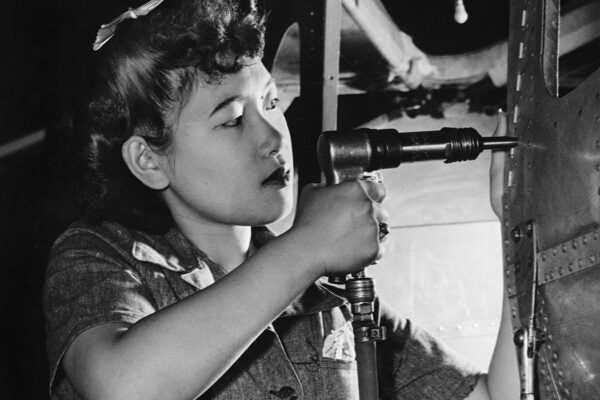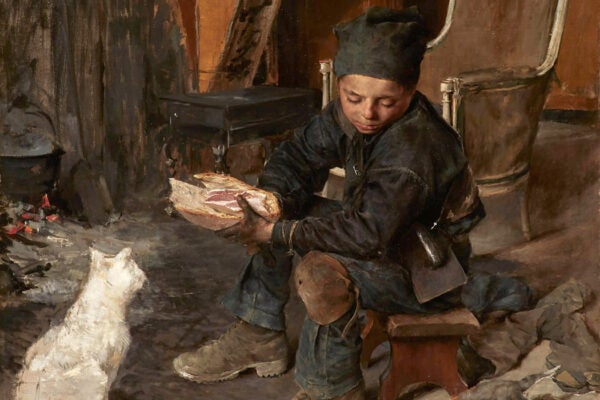In the mid-twentieth century, modern art and design represented the liberalism, individualism, dynamic activity, and creative risk possible in a free society. Jackson Pollock’s gestural style, for instance, drew an effective counterpoint to Nazi, and then Soviet, oppression. Modernism, in fact, became a weapon of the Cold War. Both the State Department and the CIA supported exhibitions of American art all over the world.
The preeminent Cultural Cold Warrior, Thomas W. Braden, who served as MoMA’s executive secretary from 1948-1949, later joined the CIA in 1950 to supervise its cultural activities. Braden noted, in a Saturday Evening Post article titled “I’m glad the CIA is ‘immoral’” that American art “won more acclaim for the U.S. …than John Foster Dulles or Dwight D. Eisenhower could have bought with a hundred speeches.”
The relationship between Modern Art and American diplomacy began during WWII, when the Museum of Modern Art was mobilized for the war effort. MoMA was founded in 1929 by Abby Aldrich Rockefeller. A decade later, her son Nelson Rockefeller became president of the Museum. In 1940, while he was still President of MoMA, Rockefeller was appointed the Roosevelt Administration’s Coordinator of Inter-American affairs. He also served as Roosevelt’s Assistant Secretary of State in Latin America.
The Museum followed suit. MoMA fulfilled 38 government contracts for cultural materials during the Second World War, and mounted 19 exhibitions of contemporary American painting for the Coordinator’s office, which were exhibited throughout Latin America. (This direct relationship between the avant-garde and the war effort was well suited: The term avant-garde actually began as a French military term to describe vanguard troops advancing into battle.)
In the battle for “hearts and minds,” modern art was particularly effective. John Hay Whitney, both a president of MoMA and a member of the Whitney Family, which founded the Whitney Museum of American Art, explained that art stood out as a line of national defense, because it could “educate, inspire, and strengthen the hearts and wills of free men.”
Whitney succeeded Rockefeller as President of the Museum of Modern Art in January 1941, so that Nelson could turn his entire attention to his Coordinator duties. Under Whitney, MoMA served as “A Weapon of National Defense.” According to a Museum press release dated February 28, 1941, MoMA would “inaugurate a new program to speed the interchange of the art and culture of this hemisphere among all the twenty-one American republics.” The goal was “Pan-Americanism.” A “Traveling Art Caravan” through Latin America “would do more to bring us together as friends than ten years of commercial and political work.”
When the War ended, Nelson Rockefeller returned to the Museum, and his Inter-American-Affairs staffers assumed responsibilities for MoMA’s international exhibition program: René d’Harnoncourt, who had headed Inter-American’s art division, became the Museum’s vice president in charge of foreign activities. Fellow staffer Porter McCray became the Director of the Museum’s International Program.
Modern art was so well aligned with American Cold War foreign policy that McCray took a leave of absence from the Museum in 1951 to work on the Marshall Plan. In 1957, Whitney resigned his position as MoMA’s Chairman of the Board of Trustees to become United States Ambassador to Great Britain. Whitney remained a trustee of the Museum while he was Ambassador, and his successor as Chairman was… Nelson Rockefeller, who had served as Special Assistant to President Eisenhower for Foreign Affairs until 1955.

Even though Modern art and American diplomacy were of a piece, Soviet propaganda asserted that the United States was a “culturally barren” capitalist wasteland. To make the case for American cultural dynamism, the State Department in 1946 spent $49,000 to purchase seventy-nine paintings directly from American Modern artists, and mounted them in a traveling exhibition called “Advancing American Art.” That exhibition, which made stops in Europe and Latin America, included work from artists such as Georgia O’Keeffe and Jacob Lawrence.
Despite positive reviews from Paris to Port au Prince, the exhibition stopped short in Czechoslovakia in 1947, because Americans themselves were indignant. Look Magazine fired off an article entitled “Your Money Bought These Paintings.” The Look piece questioned why U.S. tax dollars were being spent on such confusing pieces of art—and wondered if these were paintings even art. Harry Truman took one look at Yasuo Kuniyoshi’s painting Circus Girl Resting, which was included in the exhibit, and said, “If this is art, I’m a Hottentot.”
In Congress, Republican Representatives John Taber of New York, and Fred Busbey of Illinois worried that some of the artists held Communist sympathies, or engaged in “Un-American Activities.”
The American public’s fear of the Red Menace brought “Advancing American Art” home early, but it was precisely because Modern art was not universally popular, and was created by artists who openly disdained orthodoxy, that it was such an effective tool in showcasing the fruits of American cultural freedom to anyone looking in from abroad. President Truman personally considered Modern art, “merely the vaporings of half-baked lazy people.” But he did not declare it degenerate and expel its practitioners to gulags in Siberia. Not only that, abstract expressionism in particular was a direct repudiation of Soviet Socialist Realism. Nelson Rockefeller liked to call it “Free Enterprise Painting.”
In contrast to the Soviet Union’s “Popular Front,” the New Yorker magazine wonderfully, and perfectly, referred to the political role of American Modernism as “The Unpopular Front.” The very existence of American Modern Art proved to the world that its creators were free to create, whether you liked their work or not.
If Advancing American Art proved the nation’s artists were free because they could splatter as much paint as they wanted, it also proved that Congress could not always be induced to spend tax dollars supporting it. Braden later wrote, “the idea that Congress would have approved many of our projects was about as likely as the John Birch Society’s approving Medicare.” Clearly the State Department wasn’t the right patron for Modern Art. Which brings us to the CIA.
In 1947, at the very moment that the Advancing American Art show was being recalled, and the United States Government was selling its O’Keeffe’s for fifty bucks a-piece (all seventy-nine pieces in the show together brought in $5,544), the CIA was being created. The CIA grew out of “Wild” Bill Donovan’s Office of Strategic Services (OSS), which was the U.S.’s wartime intelligence apparatus. MoMA’s John Hay Whitney and Thomas W. Braden had both been members of the OSS.
Their fellow operatives included the poet and Librarian of Congress Archibald MacLeish, the historian and public intellectual Arthur M. Schlesinger, Jr., and the Hollywood director John Ford. By the time the CIA was codified in 1947, clandestine affairs had long been the arena of America’s cultural elite. Now, as museum staffers like Braden joined, the cultural cognoscenti and the CIA fought the Cultural Cold War side by side, with the Whitney Trust acting as a funding conduit.
Speaking of front organizations, in 1954, MoMA took over (from the State Department) the U.S. Pavilion at the Venice Biennale, so that the U.S. could continue to exhibit Modern art abroad without appropriating public funds. (MoMA owned the U.S. pavilion at Venice from 1954 to 1962. It was the only national pavilion at the show that was privately owned.)
Eisenhower made MoMA’s role as a government proxy clear in 1954, speaking at the Museum’s twenty-fifth anniversary celebration. Eisenhower called Modern art a “Pillar of Liberty,” saying:
As long as our artists are free to create with sincerity and conviction, there will be healthy controversy and progress in art. How different it is in tyranny. When artists are made the slaves and tools of the state; when artists become the chief propagandists of a cause, progress is arrested and creation and genius are destroyed.
It was MoMA’s job, concurred United States Ambassador to the Soviet Union, to demonstrate to the rest of the world “both that we have a cultural life and that we care about it.”
The CIA not only helped finance MoMA’s international exhibitions, it made cultural forays across Europe. In 1950, the Agency created the Congress for Cultural Freedom (CCF), headquartered in Paris. Though it appeared to be an “autonomous association of artists, musicians and writers,” it was in fact a CIA funded project to “propagate the virtues of western democratic culture.” The CCF operated for 17 years, and, at its peak, “had offices in thirty-five countries, employed dozens of personnel, published over twenty prestige magazines, held art exhibitions, owned a news and features service, organized high-profile international conferences, and rewarded musicians and artists with prizes and public performances.”
The CIA chose to headquarter the Congress for Cultural Freedom in Paris, because that city had long been the capital of European cultural life, and the CCF’s main goal was to convince European intellectuals, who might otherwise be swayed by Soviet propaganda, which suggested that the U.S. was home only to capitalist philistines, that in fact the opposite was true: with Europe weakened by war, it was now the United States that would protect and nurture the western cultural tradition, in the face of Soviet dogma.
Braden, writing about his role in the CCF as director of the CIA’s cultural activities, explained in 1967, “in much of Europe in the 1950’s, socialists, people who called themselves ‘left’—the very people whom many Americans thought no better than Communists—were the only people who gave a damn about fighting Communism.” When the CIA made its bid to the European intelligentsia, the Agency was waging what Braden called “the battle for Picasso’s mind,” via Jackson Pollock’s art.
Accordingly, the CIA bankrolled the Partisan Review, which was the center of the American non-Communist left, carrying enormous cultural prestige in both the U.S. and Europe because of its association with writers like T.S. Eliot and George Orwell. Unsurprisingly, the editor of the Partisan Review was the art critic Clement Greenberg, the most influential arbiter of taste, and the strongest proponent of abstract expressionism in post-war New York.
The CCF worked with MoMA to mount 1952’s “Masterpieces of the Twentieth Century” Festival in Paris. The works for the show came from MoMA’s Collection, and “established the CCF as a major presence in European cultural life,” as the historian Hugh Wilford wrote in his book The Mighty Wurlitzer: How the CIA Played America.
Curator James Johnson Sweeney made sure to note that the works included in the show “could not have been created . . . by such totalitarian regimes as Nazi Germany or present-day Soviet Russia.” Distilling this message even further in 1954, MoMA’s August Heckscher declared that the museum’s work was “related to the central struggle of the age—the struggle of freedom against tyranny.”
Editors’ Note: An earlier version of this article misquoted President Truman. He considered Modern art “merely the vaporings of half-baked lazy people,” not “the vaporizings.”
Support JSTOR Daily! Join our new membership program on Patreon today.







